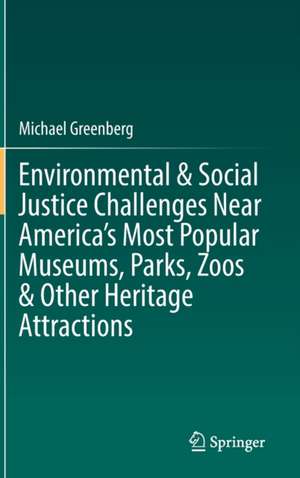Environmental & Social Justice Challenges Near America’s Most Popular Museums, Parks, Zoos & Other Heritage Attractions
Autor Michael Greenbergen Limba Engleză Hardback – 10 aug 2022
The book should have two primary audiences. One is the strong and growing social and environmental justice community that has increasingly been scrutinizing parks and other icons for evidence of injustice. This book will interest them, even though all the results do not necessarily support their positions. The second audience is businesses, not-for-profits, and government agencies who manage parks, zoos, museums, and other attractions and need to understand what is happening near their sites and what they can do to be better neighbours.
| Toate formatele și edițiile | Preț | Express |
|---|---|---|
| Paperback (1) | 778.56 lei 6-8 săpt. | |
| Springer International Publishing – 10 aug 2023 | 778.56 lei 6-8 săpt. | |
| Hardback (1) | 784.01 lei 6-8 săpt. | |
| Springer International Publishing – 10 aug 2022 | 784.01 lei 6-8 săpt. |
Preț: 784.01 lei
Preț vechi: 956.12 lei
-18% Nou
Puncte Express: 1176
Preț estimativ în valută:
150.03€ • 155.75$ • 125.11£
150.03€ • 155.75$ • 125.11£
Carte tipărită la comandă
Livrare economică 24 martie-07 aprilie
Preluare comenzi: 021 569.72.76
Specificații
ISBN-13: 9783031081828
ISBN-10: 303108182X
Pagini: 198
Ilustrații: XX, 198 p. 46 illus., 39 illus. in color.
Dimensiuni: 155 x 235 mm
Greutate: 0.5 kg
Ediția:1st ed. 2022
Editura: Springer International Publishing
Colecția Springer
Locul publicării:Cham, Switzerland
ISBN-10: 303108182X
Pagini: 198
Ilustrații: XX, 198 p. 46 illus., 39 illus. in color.
Dimensiuni: 155 x 235 mm
Greutate: 0.5 kg
Ediția:1st ed. 2022
Editura: Springer International Publishing
Colecția Springer
Locul publicării:Cham, Switzerland
Cuprins
Part1: Context and Design.- Chapter1: Creating Attractions and Tolerating Inequity.- Chapter2: Designing a Multiple-Scale and Multiple-Metric Data Analysis.- Part 2: Case Studies.- Chapter3: America’s Forever Beautiful Heritage Attraction Sites: the U.S.’s Most Popular National Parks.- Chapter4: Remnants of the Industrial Revolution: America’s Historic Grand Concourses as Heritage Attractions.- Chapter5: Zoos as Endangered Attractions.- Chapter6: America’ Iconic Urban Parks and the Gentrification Challenge.- Chapter7: Museums, the Building of Wealth Clusters, and Soft Power.- Part 3: Looking for Other Species of Heritage Sites and Better Solutions.- Chapter8: Other Species of Heritage Sites: Commercial and Political Symbols.- Chapter9: Looking for Better Affordable Housing Solutions.- Chapter 10: Epilogue: Summary and Looking Forward.
Notă biografică
Michael Greenberg is Distinguished Professor, Emeritus at the Edward J. Bloustein School of Planning and Public Policy, Rutgers University. He studies environmental health and risk analysis, having written more than 35 books and more than 350 articles. Professor Greenberg was a member of National Research Council Committees that focused on the destruction of the U.S. chemical weapons stockpile; management of nuclear weapons; degradation of the U.S. government physical infrastructure; and sustainability. He served on a U.S.EPA Science Advisory Board environmental justice committee and he chaired a committee for the U.S. Senate and House Appropriations Committees examining the U.S. DOE’s prioritization of human health and safety in its environmental management programs. Professor Greenberg was area editor for social sciences and then editor-in-chief of Risk Analysis: An International Journal during the period 2002-2013, and he was associate editor for environmental health for the American Journal of Public Health for 22 years.
Textul de pe ultima copertă
This book examines environmental and social justice challenges near America's most popular heritage attractions. These include over 100 places that host national parks (e.g., Glacier, Yellowstone), zoos (e.g., Bronx, Henry Doorly), urban parks (e.g., Central Park, Fairmount), grand concourses (e.g., 5th Avenue, Massachusetts Avenue), and multiple museums and galleries (e.g., National Gallery, Getty). The book includes measurements of demographics, air quality/distance from hazards, health outcomes, and urban assets in the areas immediately surrounding these heritage sites and compares them with adjacent areas and their host cities or states. It considers the history of justice-related-issues near the sites and evaluates what owners, managers and communities are doing to address gentrification, displacement, the legacy of redlining and other challenges, such as the animal rights movement, climate change/sustainability, and tight budgets. The book examines what some host cities are doing about affordable housing and what some heritage sites have done in establishing constructive relationships with surrounding communities.
The book should have two primary audiences. One is the strong and growing social and environmental justice community that has increasingly been scrutinizing parks and other icons for evidence of injustice. This book will interest them, even though all the results do not necessarily support their positions. The second audience is businesses, not-for-profits, and government agencies who manage parks, zoos, museums, and other attractions and need to understand what is happening near their sites and what they can do to be better neighbours.
The book should have two primary audiences. One is the strong and growing social and environmental justice community that has increasingly been scrutinizing parks and other icons for evidence of injustice. This book will interest them, even though all the results do not necessarily support their positions. The second audience is businesses, not-for-profits, and government agencies who manage parks, zoos, museums, and other attractions and need to understand what is happening near their sites and what they can do to be better neighbours.
Caracteristici
Examines environmental and social justice challenges near America's most popular parks, zoos, museums, and concourses Evaluates the extent of inequity measured by demographics, distance from hazards, and health outcomes and behaviors Considers the history of the issues near the sites and evaluates what owners and managers are doing to address them
